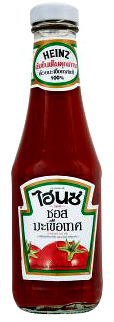 Tomato ketchup (or “catsup” if you are of an American persuasion) is surprisingly popular in Thailand. Most supermarkets stock at least 2 or 3 brands, foremost amongst them being Heinz. Admittedly, there is probably an equal volume of sweetish chilli sauces alongside, including one by Heinz, but tomato sauce is undoubtedly a favourite here.
Tomato ketchup (or “catsup” if you are of an American persuasion) is surprisingly popular in Thailand. Most supermarkets stock at least 2 or 3 brands, foremost amongst them being Heinz. Admittedly, there is probably an equal volume of sweetish chilli sauces alongside, including one by Heinz, but tomato sauce is undoubtedly a favourite here.
If you order French fries, then there will inevitably be a small dish of the sauce to dip them in. (French fries are seen here more as a snack food for drinking with beer than an accompaniment to a main dish.)
Tomato sauce has also long been incorporated into Thai cuisine. It appears in recipes for “peak kai lao daeng” (deep fried chicken extremities in a kind of reddish local gutrot-enhanced sauce) as well as in the Thai version of sweet and sour pork (which is rather less gloopy than the Chinese version one endures in the West). There are even some versions of the Thai national dish, Phad Thai, which include it, though this is an abomination.
Phad Thai is one of the few dishes that can be considered to have a definitive recipe. It’s not a traditional Thai dish, but was rather the winner of a competition to create as a new national dish at the behest of Field Marshall Plaek Phibunsongkhram in the late 1930s or thereabouts when he was avidly trying to create a unified national Thai identity. He also wanted to wean Thai people off rice and on to noodles. Though at the time he held the notional title of “Prime Minister”, it’s probably better to consider him a fascist dictator along the lines of Mussolini – a role he held from 1938 to 1957 with a four year break in the middle. He was also responsible for changing the country’s name from Siam to Thailand, and for the the rewriting of the words to the National Anthem along suitably jingoistic lines. Despite being of Chinese ancestry himself he led a campaign to boycott all Chinese owned businesses in the Kingdom, and one of his charming henchmen (also of Chinese ancestry) notoriously likened the Chinese in Thailand to the Jews in Germany. So perhaps Mussolini and Goebels rolled into one. But enough of good soldier Phlaek, though I can be pretty sure he wouldn’t have approved of American ketchup in his fried noodles.
Another major use of tomato ketchup here is to slather liberally over pizza. Every pizza restaurant has a bottle or sachets of the condiment at the table. Even the upmarket place I order home delivery from (and which actually does a pretty good, authentic version of the fired dough) includes a few sachets of the stuff Sellotaped to the box.
Given some of the strange perversions of pizza that appear here, an overdose of tomato slop might actually be the only way to make them palatable. Artificial crab sticks and mayonnaise pizza with frankfurter-stuffed crust anybody?
And to the point of my ramblings: a few days ago I bought a packet of locally made frozen gyoza (Japanese dumplings) for lunch. The accompanying pouch of soy-based dipping sauce felt a little strange. Once I’d defrosted it I had a taste. Yes, it was that staple of high Japanese cuisine, tomato ketchup. Only (at least, I hope only) in Thailand.
[668]

Recent Comments